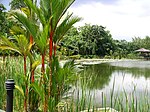Istana Tyersall
1892 establishments in Singapore1892 establishments in the British Empire1892 establishments in the Straits Settlements1905 disestablishments in Singapore1905 disestablishments in the British Empire ... and 9 more
1905 disestablishments in the Straits SettlementsBuildings and structures demolished in 1935Demolished buildings and structures in SingaporeHouses completed in 1892Palaces in SingaporePlaces in SingaporeProtected areas of SingaporeRoyal residences in SingaporeUse Singapore English from July 2018

Istana Tyersall is a demolished historical palace that used to be in the former Tyersall Park bound by Holland Road and Tyersall Road near the Singapore Botanic Gardens in Singapore. The land it was formerly built on is currently restricted from the public.The demolished palace had long been confused with the dilapidated Istana Woodneuk due to its proximity, which was located on another smaller hill not far away. The difference with the roof tiles of these former palaces is that while Woodneuk was blue, Tyersall was red.
Excerpt from the Wikipedia article Istana Tyersall (License: CC BY-SA 3.0, Authors, Images).Istana Tyersall
Circle road, Singapore Tanglin
Geographical coordinates (GPS) Address Nearby Places Show on map
Geographical coordinates (GPS)
| Latitude | Longitude |
|---|---|
| N 1.3111111111111 ° | E 103.81055555556 ° |
Address
Circle road
Circle road
258853 Singapore, Tanglin
Singapore
Open on Google Maps








